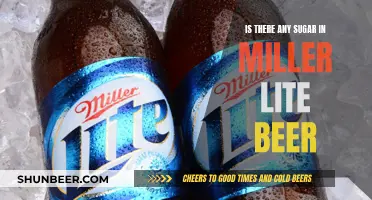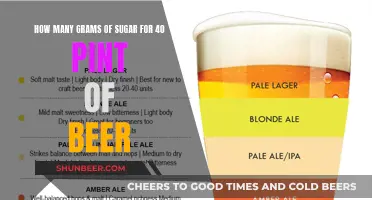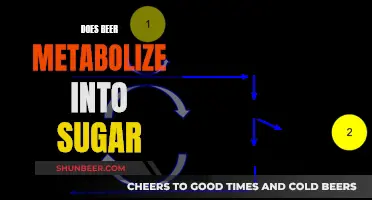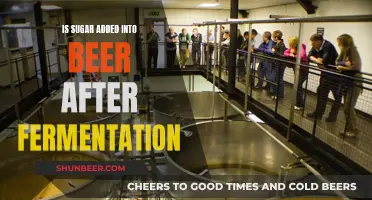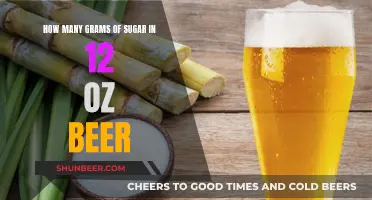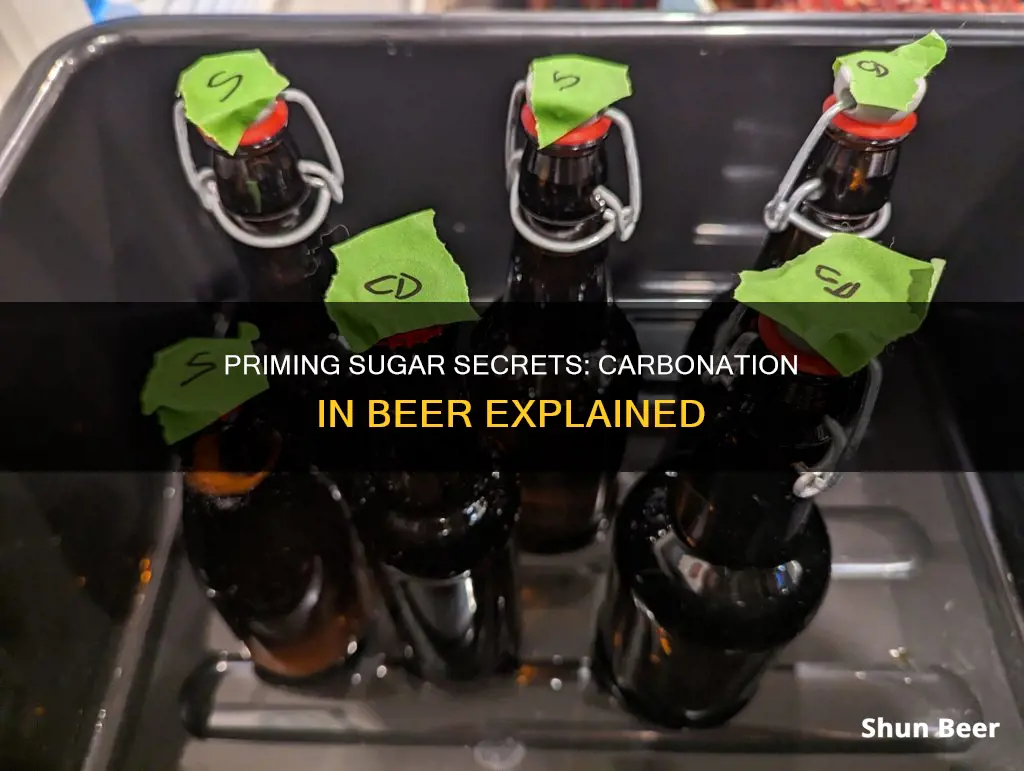
Carbonation is essential to bring out the best flavours and thirst-quenching zing in beer. To achieve this, brewers rely on a priming solution. Adding a sugar-based priming solution to the brew as you bottle it provides food for the yeast to create effervescence, or carbonation, over a two-week period as the beer ages in the bottle. This effervescence is carbon dioxide (CO2). As the yeast feeds on the sugar in the priming solution, it generates CO2, adding bubbles to the brew.
What You'll Learn

How to calculate the amount of priming sugar needed
Factors Affecting the Amount of Priming Sugar
Priming sugar is added to beer during bottling to create carbonation. The amount of priming sugar you need depends on several factors, including the type of sugar used, the volume of your brew, and your target carbonation level.
Using a Priming Sugar Calculator
The easiest way to calculate the amount of priming sugar needed is to use a priming sugar calculator. These calculators take into account factors such as fermentation temperature, CO2 volume, beer style, and volume of brew to determine the amount of priming sugar required. It is recommended to add priming sugar by weight rather than volume for more accurate measurements.
Manual Calculations for Different Types of Priming Sugars
If you prefer to calculate the amount of priming sugar manually, you can use specific formulas for different types of priming sugars:
Corn Sugar (Dextrose)
The formula for corn sugar, which contains roughly 9% water, is:
CF + .5 x (.91D)/VB = CB
Where:
- CF is the level of CO2 in your flat brew (in grams/litre)
- D is the amount of corn sugar (in grams)
- VB is the volume of your brew (in litres)
- CB is the carbonation level of your finished beer (in litres)
Table Sugar (Sucrose)
Table sugar does not contain water, so the formula is slightly different:
CF + .5(S)/VB = CB
Where:
- CF is the level of CO2 in your flat brew (in grams/litre)
- S is the amount of table sugar (in grams)
- VB is the volume of your brew (in litres)
- CB is the carbonation level of your finished beer (in grams/litre)
Dry Malt Extract (DME)
To calculate the amount of DME needed, you must also know the fermentability of the DME, also known as the limit of attenuation. This is calculated as:
FA x .82 = FT
Where:
- FA is the apparent fermentability
- FT is the true fermentability
Once you have the true fermentability, you can calculate the amount of DME needed using the following formula:
CF + .5FTx (X/VB) = CB
Where:
- CF is the level of CO2 in your flat brew (in grams/litre)
- FT is the true fermentability of the DME
- X is the amount of DME (in grams)
- VB is the volume of your brew (in litres)
- CB is the carbonation level of your finished beer (in grams/litre)
Honey
Honey can be a more challenging priming agent due to variations in density, composition, and viscosity. To calculate the amount of honey needed, you must first determine its specific gravity by creating a 10% honey solution and measuring its specific gravity relative to a 10% sucrose solution. Then, calculate the amount of sucrose needed for your brew and divide it by the fraction obtained from the specific gravity measurement.
Brewer's Rule of Thumb
As a general rule of thumb, for every five gallons of beer, you will need:
- 3/4 cups (6 ounces or 113 grams) of corn sugar (dextrose)
- 2/3 cup (5.3 ounces or 150 grams) of table sugar
- 1 1/4 cups (181 grams) of light dry malt extract (DME)
- 1/2 to 1 cup of honey, depending on composition
Tips for Priming Your Homebrew
When preparing your priming solution, it is important to boil the water first and then add the sugar, stirring until it is completely dissolved. Be sure to sanitize all equipment, including bottles and caps, before bottling your beer. Additionally, take care not to introduce oxygen into the brew during bottling, as this can cause problems with the flavor.
Blue Moon Beer: Sugar Content and Nutritional Facts
You may want to see also

The role of temperature in the carbonation process
The temperature of the beer and the pressure of the carbon dioxide in the headspace will determine the amount of carbon dioxide dissolved in the beer. A higher temperature will result in a non-linear decrease in the amount of carbon dioxide dissolved, while increasing pressure will lead to a linear increase. Therefore, to increase the solubility of carbon dioxide in beer, the temperature must be decreased and/or the pressure must be increased.
The temperature also affects the yeast activity and carbonation levels during the fermentation process. Higher temperatures often lead to faster fermentation and potentially higher carbonation. Additionally, the temperature reached during the initial fermentation can be used to estimate the residual carbonation, which is important for determining the proper amounts of priming sugar to add to the beer.
During the bottling process, the temperature of the beer should be controlled to prevent splashing, as this can introduce oxygen into the brew, causing off-flavours.
Cider Beers: Sugar Content and Health Considerations
You may want to see also

The best types of sugar for priming beer
When it comes to priming beer, you can use any type of fermentable sugar. However, some sugars are better than others at bringing desirable qualities to your beer, such as taste and aroma.
Corn Sugar (Dextrose)
Corn sugar is the best option for new homebrewers. It is very soluble, easy for yeast to digest, and widely available in pre-packaged amounts from homebrew stores. It also does not influence the taste of the finished beer.
Table Sugar (Sucrose)
Table sugar is a basic and appealing option due to its low cost and easy availability. It also does not add any flavour to the beer, so it can be used for any kind. However, table sugar is a disaccharide, which means yeast has to work harder to split it, potentially resulting in stressed and weak yeast that produces off-flavours.
Dry Malt Extract (DME)
Dry malt extract is an unfermented wort that has been dried into powder form. It helps to add flavour and body to the beer and some brewers argue that it gives finer bubbles than sugar. However, it can take longer to fully ferment, which may cause the bubbles to initially appear smaller.
Natural Sugars
Dark brown sugar and honey are natural, unrefined sugars that will give your beer a subtle aftertaste, amplified taste, and a nicer aroma. However, honey is difficult to prime with as there is no standard for concentration. The gravity of honey differs from jar to jar, so to use it, you will need to dilute it and measure its gravity with a hydrometer.
Calculating Beer Sugar Content for Weight Watchers
You may want to see also

How to add priming sugar to beer
Now that your beer is fermented and has been sitting to age for a week or two, it's time to prime your brew. Priming sugar is the primary component in the priming solution and is essential to ensuring your hard work pays off.
Step 1: Prepare the Bottles
Sanitize each bottle, preferably with a no-rinse brewing sanitizer like Star-San. Be sure to inspect old bottles for mould.
Step 2: Get the Bottle Caps Ready
Sanitize the caps, too. You may opt for Grolsch-style bottles and sanitise the rubber seals.
Step 3: Prepare Your Priming Sugar Solution
To ensure the sugar dissolves evenly, boil about two cups of water and dissolve your sugar in it. Bring the solution to a boil and then turn off the heat source, allowing the solution to cool.
Step 4: Combine the Beer and Priming Sugar Solution
Pour the cooled priming sugar solution into your bottling bucket and siphon the beer on top. Gently stir the beer with a sanitized spoon. If you don't have a bottling bucket, you can pour the priming solution into your fermenter and gently stir. Allow the sediment to settle for 15 to 30 minutes before bottling.
Step 5: Bottle Your Beer
Carefully transfer your brew to your bottles, filling them to the top. Capping your beers with a handheld capper, set them aside in a dry, room-temperature place so the yeast will remain active and generate carbonation as they consume the priming sugar solution.
Step 6: Wait
Wait two weeks for fermentation to complete. After this time, chill one beer, then crack it open to test it. If it needs a little longer, allow the remaining bottles to age for a few more days.
Tips
- Corn sugars are the best choice if you are new to homebrewing. It is very soluble, easy for yeast to digest, and widely available.
- For lower carbonation, use 3.7 oz of priming sugar per 5 gallons of beer instead of the standard 5 oz.
- If you have less or more than 5 gallons of beer, use this calculation to determine how much priming sugar to use: (5 oz) (quantity of beer in gallons) / (5 gallons).
Beer vs. Whiskey: Sugar Content Face-off
You may want to see also

The benefits of carbonation for beer
Carbonation is an essential part of the beer-making process, and the final carbonation level will have a significant impact on the taste and mouthfeel of the beer. The benefits of carbonation for beer are numerous, and the process is a fascinating one.
Firstly, carbonation enhances the flavour and aroma of the beer. The carbon dioxide (CO2) bubbles help to release the various flavour compounds in the beer, intensifying the taste experience. This is especially true for beers with complex flavour profiles, such as Belgian lambics or sour beers. The effervescence also contributes to a crisp, refreshing mouthfeel, making the beer more thirst-quenching.
Secondly, carbonation affects the head retention of the beer. A well-carbonated beer will have a nice, stable head, which is important for both the appearance and the aroma of the beer. The bubbles help to trap the beer's volatile compounds, releasing them when the drinker takes a sip, thus enhancing the overall sensory experience.
Thirdly, carbonation influences the perceived body and texture of the beer. The tiny bubbles can give the beer a smoother, more velvety texture, especially when combined with the right balance of malt and hops. This carbonation can also help to balance out any bitterness from the hops, creating a more rounded, pleasing palate.
Additionally, carbonation plays a crucial role in the preservation of the beer. CO2 is an inert gas that helps to prevent oxidation and microbial growth, thus extending the shelf life of the beer. This is why flat beer, which has lost its carbonation, often tastes stale or off.
Finally, the carbonation level can be used to adjust the overall impression of the beer. A highly carbonated beer will feel lighter and more effervescent, while a less carbonated beer may feel heavier and more full-bodied. This allows brewers to fine-tune their beers to match the desired style and flavour profile.
In summary, carbonation is a critical aspect of beer-making, and when done right, it enhances the beer's flavour, aroma, mouthfeel, and overall quality. It is a key factor in creating a well-rounded, refreshing, and enjoyable beer.
Beer Sugar Content: Is It Really That High?
You may want to see also
Frequently asked questions
Priming sugar is any fermentable sugar added to beer to carbonate it and give it fizz.
The residual yeast in the beer feeds on the priming sugar, producing carbon dioxide (CO2) and adding bubbles to the brew.
Popular priming sugars include corn sugar (dextrose), table sugar (sucrose), and dry malt extract (DME).


